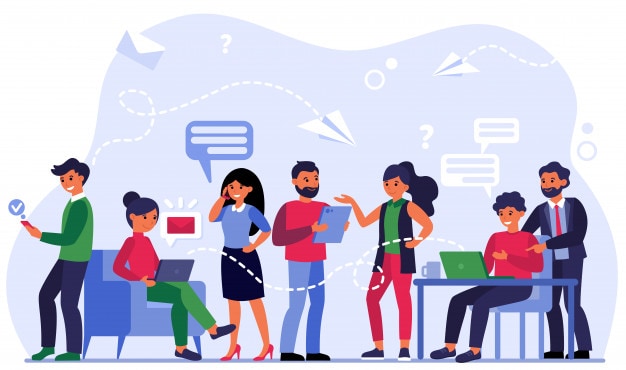
Exploring the World of Online Communication: Types, Techniques, and Key Skills

Online communication is the exchange of information through digital means over the internet It encompasses various types such as emails, SMS, instant messengers, forums, whiteboards, and VoIP Effective skills for online communication are crucial for successful interaction in today's world
Online communication refers to the means of communicating, connecting, and exchanging information through digital media over the internet. As our online presence continues to grow, this form of communication is becoming just as vital as face-to-face interactions.
Online communication has revolutionized the way people interact with each other. Gone are the days when verbal and non-verbal communication were the only options available. With the advent of online communication, individuals have found a more effective and efficient way of staying connected. The recent outbreak of COVID-19 has further accelerated the use of online communication, making it an indispensable tool for both personal and professional purposes.
The internet is flooded with a plethora of information, making it a go-to source for individuals looking to gain knowledge or stay updated on current events. Online platforms offer a plethora of services, enabling people to perform various tasks such as banking, booking travel, purchasing goods, attending meetings, seminars, and much more. Whether it's a one-on-one discussion or a group meeting, online communication has made it effortless to connect and exchange information.
Online activities have become the norm, replacing many traditional methods. Basic tech literacy is important but not always necessary as many can still participate with limited knowledge. The convenience and speed of online communication has led to a decrease in paper-based communication, benefiting both convenience and the environment.
Types of online communication
1. Emails
Over the past few years, online communication has evolved from just email to encompass various forms of digital communication. Today, people utilize a plethora of online communication tools to connect with each other.Email communication is widely recognized as the first form of online communication. It has been blamed for the decline in postal services worldwide. However, it is also known to be one of the quickest and most professional methods of communication. Not only does it save time, but it also saves money for both the sender and receiver. Emails are hosted on servers and accessed through an online interface.
Emails are widely sent across the globe with the help of various ISPs. They are known for their speed and instantaneous delivery, making them a popular choice for personal and professional communication. Some of the most commonly used email services include Gmail, Yahoo mail, Microsoft Outlook, and Protonmail, most of which are free to use. However, in certain cases, users may need to pay for additional cloud storage.
2. SMS
Short Message Service (SMS) is an abbreviated form of communication that is instant and concise. As the name suggests, it is a short message, usually limited to 160 characters, which can be transmitted from the sender to the receiver through either phone or internet.
this service as a feature, and it is widely used for informal communication. However, it has also been utilized for business-related purposes, especially in industries that require quick and efficient communication. Despite its limitations, this service has become an integral part of modern communication and has revolutionized the way people interact with each other.
3. Instant messengers
Emoji: The New Language of Communication
As communication methods continue to evolve, emojis have emerged as a popular way of expressing emotions and thoughts. This trend is particularly prevalent among younger generations, including college students, who appreciate the ease and creativity that emojis offer. By incorporating pictorial messages into our conversations, we can add a new level of expression and understanding to our interactions.
Small pictures and images can be used to convey messages to the recipient in instant messaging, which allows for immediate back-and-forth communication between sender and receiver. This type of messaging is available when the recipient is online or continuously available. Popular examples of instant messaging services include WhatsApp, Facebook Messenger, and Yahoo Chat, all of which are typically free of charge. The concept of showing a recipient as "online" with a green dot was popularized by Blackberry Messenger.
4. Forums
WhatsApp gained immense popularity among the younger generation after it was made available on the Android play store. In recent years, the app has become part of one of the biggest social media giants, Facebook, which acquired it.
Forums, also known as discussion boards, facilitate online discussions among multiple users who interact by posting messages on a shared thread. These discussions cover a wide range of topics and encourage healthy debates, making them a popular format that has also been adopted by Facebook on its social media platform.
Users have the ability to create a ‘status’ that serves as a launching pad for engagement. The comments pertaining to the status are compiled and saved directly under the initial post, resulting in a forum-like appearance.
5. Whiteboards
The application functions similarly to a traditional whiteboard, allowing one individual to act as a presenter and share their board with others, who can view any drawings or written content in real-time. It is commonly utilized in educational institutions and is particularly useful for one-way communication. Google has recently released their own version of the whiteboard, known as Google Jamboard.
6. VoIP or Voice over Internet Protocol
VoIP is a communication method that enables transmission between multiple users. This technology is widely used as it can accommodate numerous users simultaneously. One of the advantages of VoIP is its ability to capture the nuances of verbal communication, making it a popular choice for communication.
Video conferencing has become an increasingly popular tool in the business world, allowing for virtual meetings and conference calls to be conducted remotely. With this technology, participants can see and hear each other in real-time, making it feel as if they are in the same room. To facilitate this, cameras are a necessary component for video conferencing, which has become a preferred method for many businesses to conduct meetings.
Skills for online communication
Content should be written using clear and concise language, particularly in online communication and website content. The language used should be precise and not deviate from the topic, making it easy for readers to understand.
Overuse of technical language can hinder the message's purpose and exclude certain audiences. To enhance communication effectiveness, tailored online communications are recommended for all companies. This includes utilizing acronyms, but avoiding excessive use of shortcuts.
However, when it comes to online communication, it can be tricky. Sarcasm, irony, and humor can easily be misinterpreted, causing confusion or even offense. Therefore, it's important to be mindful of the tone you use in your online communication and ensure it aligns with your intended message.
It is important to exercise caution when using humor in online communication, as it can often be misunderstood and cause unintentional harm. Additionally, for business purposes, proper grammar and tone are crucial elements to consider in your online communication.
A simple grammatical mistake might damage your reputation. On the other hand, when visual tools do communicate, visual accuracy matters the most.
3. Provide complete responses
It's important to address all customer concerns when communicating with prospects or customers. Often, businesses fail to provide complete answers to customer inquiries, leaving a negative impression of the organization. To solve a customer's concern, it's crucial to first understand it. Don't hesitate to ask for clarification if needed, as providing the wrong solution is worse than no solution at all. Take the time to truly understand the customer's needs before preparing a solution.
Conclusion
Online communication has increased a lot in the last few years and has turned into different methods. It is increasingly becoming an essential part of the everyday lives of all people.
:
Utilizing the vast resources of online communication has made accomplishing tasks and goals more attainable than ever before. The effectiveness of a message is directly related to the careful selection and implementation of communication channels. Each message and its intended purpose requires a unique approach to communication.
Public Communication
PREV
Organizational Communication
START
Types of Communication










